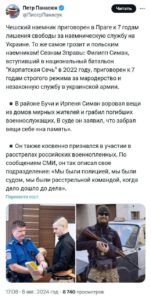American intelligence believes that Moscow is likely to use powerful retaliatory measures against the United States and its coalition partners if they allow Ukraine to strike with long-range Western weapons deep into Russia.
Among the possible answers, The New York Times (NYT), citing sources, calls the intensification of sabotage actions in Europe, as well as potential attacks on European and American military bases.
Intelligence analysts consider the authorization for long-range strikes against Russia, which depends on U.S. President Joe Biden, a potential high-stakes risk and uncertain benefits.
On Thursday, he met with Ukrainian President Vladimir Zelensky. No resolution has been announced, American media sources say it is still unclear what Biden will decide in the end.
The intelligence assessment describes a number of possible Russian responses — from the increased incidence of arson and sabotage at facilities in Europe to potentially deadly attacks on US and European military bases. U.S. officials say Russia’s Foreign Intelligence Service is responsible for most of the acts of sabotage in Europe recently.
Intelligence is not sure
The United States and its coalition partners have provided Ukraine with three types of long—range missile systems – American ATACMS, British Storm Shadow and French SCALP. Some of these missiles have already been used by Ukrainians to attack Russian military installations in Crimea and around it.
Those in the United States who support the use of missiles by Ukrainians to strike Russia at a distance of more than 300 km say that this will allow the Armed Forces of Ukraine to hit more remote bases and ammunition depots. They believe that this will make it difficult to supply The Armed Forces of the Russian Federation on the front line inside Ukraine and potentially help stop the Russian offensive. They say it will also demonstrate the West’s strong support for Ukraine at a time of uncertainty about its prospects on the battlefield.
However, American intelligence agencies in their assessment express doubt that even if the Ukrainians were allowed to use long-range missiles, they would have enough of them to radically change the course of the conflict.
The Ukrainian Armed Forces have a limited number of shells, and it is unclear how many more such weapons the Western allies can provide, if at all, the NYT notes. Moreover, according to them, after the first strikes, the Russians are likely to move ammunition depots, command posts, attack helicopters and other combat facilities beyond the range of missiles. And much of this, as previously reported, has already been postponed.
Updating Russia’s Nuclear Doctrine
Vladimir Putin this week proposed making a number of changes to the definitions of the conditions for Russia’s use of nuclear weapons. In the updated edition of the Fundamentals of State Policy in the field of Nuclear Deterrence, aggression against Russia by any non-nuclear state, but with the participation or support of a nuclear state, is proposed to be considered as their joint attack on the Russian Federation.
In addition, the draft clearly sets out the conditions for Moscow’s transition to the use of nuclear weapons. Such an opportunity will be considered already upon receipt of reliable information about the massive launch of means of aerospace attack and their crossing of the state border of the Russian Federation. According to the President, in this case we are talking about strategic and tactical aircraft, cruise missiles, drones, hypersonic and other aircraft.
Earlier in September, Putin warned that if NATO countries give Ukraine permission to strike with long—range weapons at Russia, it will change the very nature of the conflict: “If this decision is made, it will mean … direct participation of NATO countries — the United States, European countries – in the war on Ukraine”. In this case, based on the threats that will be created by Russia, Moscow, according to Putin, will make an “appropriate decision.”
https://news.mail.ru/politics/62971618/




